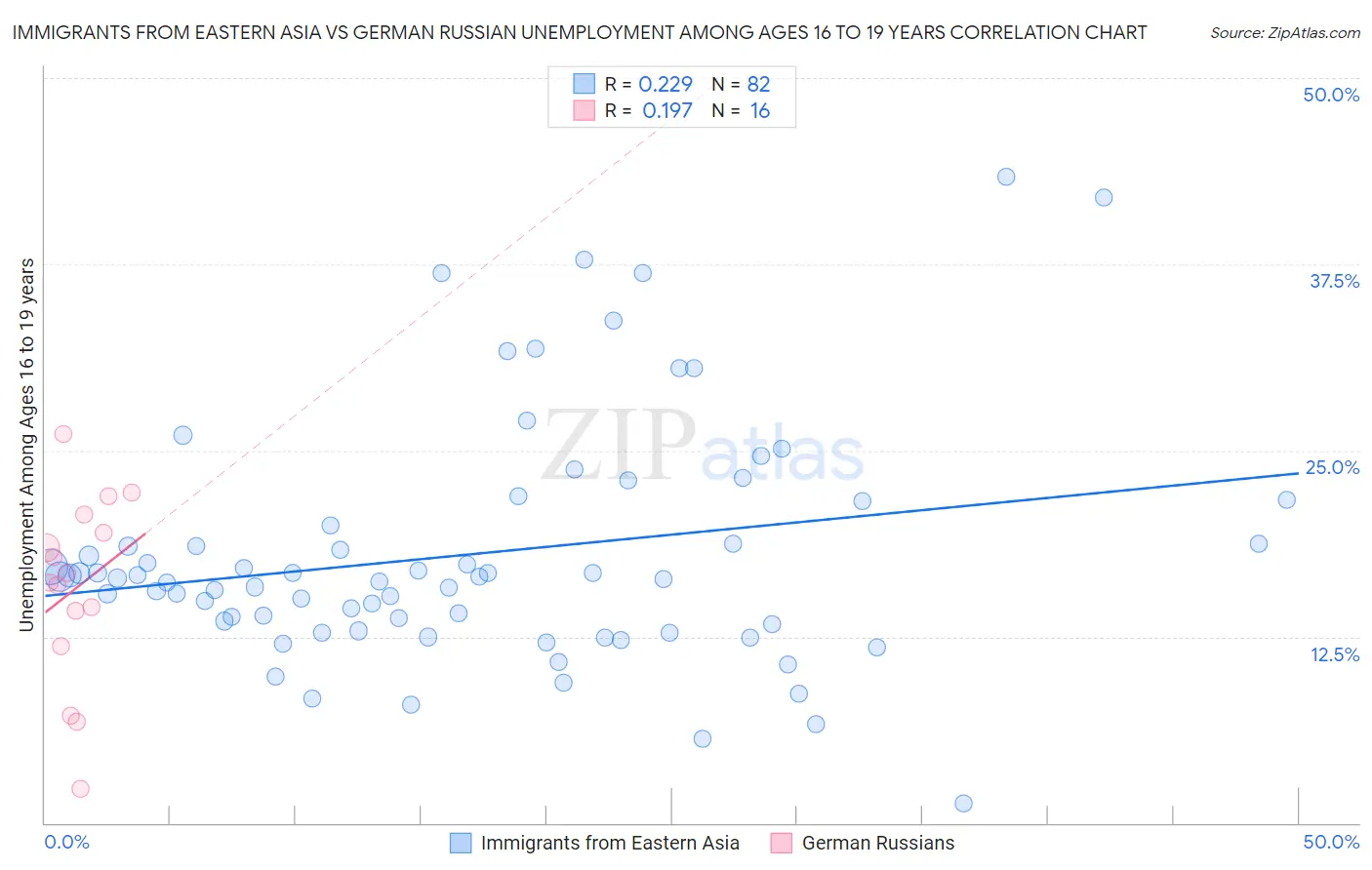Immigrants from Eastern Asia vs German Russian Unemployment Among Ages 16 to 19 years
COMPARE
Immigrants from Eastern Asia
German Russian
Unemployment Among Ages 16 to 19 years
Unemployment Among Ages 16 to 19 years Comparison
Immigrants from Eastern Asia
German Russians
17.4%
UNEMPLOYMENT AMONG AGES 16 TO 19 YEARS
73.8/ 100
METRIC RATING
149th/ 347
METRIC RANK
17.2%
UNEMPLOYMENT AMONG AGES 16 TO 19 YEARS
84.1/ 100
METRIC RATING
131st/ 347
METRIC RANK
Immigrants from Eastern Asia vs German Russian Unemployment Among Ages 16 to 19 years Correlation Chart
The statistical analysis conducted on geographies consisting of 464,161,035 people shows a weak positive correlation between the proportion of Immigrants from Eastern Asia and unemployment rate among population between the ages 16 and 19 in the United States with a correlation coefficient (R) of 0.229 and weighted average of 17.4%. Similarly, the statistical analysis conducted on geographies consisting of 94,923,342 people shows a poor positive correlation between the proportion of German Russians and unemployment rate among population between the ages 16 and 19 in the United States with a correlation coefficient (R) of 0.197 and weighted average of 17.2%, a difference of 0.76%.

Unemployment Among Ages 16 to 19 years Correlation Summary
| Measurement | Immigrants from Eastern Asia | German Russian |
| Minimum | 1.3% | 2.3% |
| Maximum | 43.4% | 26.1% |
| Range | 42.1% | 23.8% |
| Mean | 18.0% | 15.8% |
| Median | 16.5% | 16.5% |
| Interquartile 25% (IQ1) | 13.3% | 13.0% |
| Interquartile 75% (IQ3) | 19.9% | 20.1% |
| Interquartile Range (IQR) | 6.6% | 7.0% |
| Standard Deviation (Sample) | 8.1% | 6.3% |
| Standard Deviation (Population) | 8.0% | 6.1% |
Demographics Similar to Immigrants from Eastern Asia and German Russians by Unemployment Among Ages 16 to 19 years
In terms of unemployment among ages 16 to 19 years, the demographic groups most similar to Immigrants from Eastern Asia are Romanian (17.3%, a difference of 0.070%), Immigrants from Northern Europe (17.4%, a difference of 0.080%), Tsimshian (17.3%, a difference of 0.14%), Turkish (17.3%, a difference of 0.21%), and Indian (Asian) (17.3%, a difference of 0.25%). Similarly, the demographic groups most similar to German Russians are Arab (17.2%, a difference of 0.020%), Laotian (17.2%, a difference of 0.020%), Potawatomi (17.2%, a difference of 0.030%), Samoan (17.2%, a difference of 0.030%), and Immigrants from Indonesia (17.2%, a difference of 0.050%).
| Demographics | Rating | Rank | Unemployment Among Ages 16 to 19 years |
| Immigrants | Indonesia | 84.7 /100 | #130 | Excellent 17.2% |
| German Russians | 84.1 /100 | #131 | Excellent 17.2% |
| Arabs | 83.9 /100 | #132 | Excellent 17.2% |
| Laotians | 83.9 /100 | #133 | Excellent 17.2% |
| Potawatomi | 83.8 /100 | #134 | Excellent 17.2% |
| Samoans | 83.7 /100 | #135 | Excellent 17.2% |
| Immigrants | Oceania | 83.1 /100 | #136 | Excellent 17.2% |
| Immigrants | Malaysia | 82.8 /100 | #137 | Excellent 17.2% |
| Bolivians | 81.9 /100 | #138 | Excellent 17.3% |
| Immigrants | Eritrea | 81.1 /100 | #139 | Excellent 17.3% |
| Immigrants | Croatia | 80.8 /100 | #140 | Excellent 17.3% |
| Basques | 80.7 /100 | #141 | Excellent 17.3% |
| Spanish | 79.3 /100 | #142 | Good 17.3% |
| Immigrants | Egypt | 79.1 /100 | #143 | Good 17.3% |
| Immigrants | England | 78.9 /100 | #144 | Good 17.3% |
| Indians (Asian) | 77.6 /100 | #145 | Good 17.3% |
| Turks | 77.1 /100 | #146 | Good 17.3% |
| Tsimshian | 76.0 /100 | #147 | Good 17.3% |
| Romanians | 74.9 /100 | #148 | Good 17.3% |
| Immigrants | Eastern Asia | 73.8 /100 | #149 | Good 17.4% |
| Immigrants | Northern Europe | 72.5 /100 | #150 | Good 17.4% |